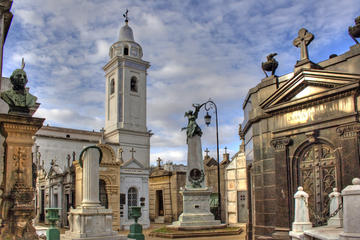What to See in Buenos Aires – A 3-Day Visit

A Note About My What To See in Buenos Aires - A 3-Day Visit Page
My “What to see during a 3-day visit to Buenos Aires” page is extremely special to me as Buenos Aires was my last trip before the Covid-19 Pandemic hit. I went on this trip from December 25th, 2019, until January 1st, 2020. This page took me almost eight months to complete. It seems like I kept putting off finishing it as when it was completed my traveling would officially be done for a while.
What To See: Buenos Aires, Argentina - Table of Contents
Disclaimer: Buzzin’ Around the World strives to provide accurate and up-to-date information based on our research at the time of publication. We respect all applicable laws and fair use principles. If you believe any information is incorrect or violates regulations, please contact us at buzzinaroundtheworld@gmail.com.
Affiliate Links and Reviews: We use affiliate links to generate income and may receive a commission at no additional cost to you when you use our links. We strive for honest and transparent reviews, even for products which we receive compensation.
Content Creation: Our content is based on our own travel experiences. All photos are our own unless otherwise stated. We sometimes utilize AI tools to assist with tasks like generating titles, summarizing content, and improving organization.
For more information: For more information, please click HERE to visit our private policy page. We can be reached at buzzinaroundtheworld@gmail.com.
What To See in Buenos Aires - Plaza de Mayo
The Plaza de Mayo is the most famous of Argentina’s plazas and home to some of the most important buildings in Buenos Aires. Included in the Plaza de Mayo are the Casa Rosada (president’s house), Buenos Aires Cathedral, Argentinian National Bank, Buenos Aires City Hall, and the Cabildo.
The Plaza dates back to 1884 and gets its name from the May Revolution of 1810, which led to Argentina’s independence from Spain six years later.
The Pirámide de Mayo (May Pyramid) is located in the center of the Plaza next to a large Argentinian flag. I highly recommend starting your Buenos Aires sightseeing at the Plaza de Mayo as you can see some of the most well-known buildings in all of Buenos Aires.
Plaza de Mayo can be reached by the following Subte Stations:
Plaza de Mayo (Line A), Catedral (Line D), and Bolivar (Line E)


What To See in Buenos Aires - Casa Rosada
The Casa Rosada (Pink House) is the executive mansion and workplace of the President of Argentina. Completed in 1886, this iconic building is one of the most recognizable buildings in all of Argentina. The pink color can be traced back to the presidency of Domingo Faustino Sarmiento. Sarmiento ordered the building painted pink to ease the tensions between the Federals and Unitarians. The pink color was a result of mixing the colors of the two parties. The Federals’ color was red, and the Unitarians’ color was white.
The Casa Rosada houses a museum which is open from Wednesday to Sunday from 10:00 am to 6:00 pm. Tours are also available on Saturdays at 12:30 pm free of charge.
Be sure to look at the balcony, where Juan and Eva Perón addressed huge crowds of people during the 1940s and 1950s.




 Private guided Walking Tour Plaza de Mayo y Casa Rosada - $23.99 This walking guide tour to visit one of the most of the picturesque neighborhood in the city, with a walk through history, tradition and the way to the Independence of Argentina. |
What To See in Buenos Aires - Cathedral de Buenos Aires
Originally built during the 16th century, the Buenos Aires Metropolitan Cathedral has been rebuilt many times, with the most recent being completed in 1791. I visited the cathedral on Christmas Day of 2019 and was able to enter, walk around and take pictures.
Located inside the cathedral are multiple mausoleums, including the remains of General Jose de San Martin, General Juan Gregorio de las Heras, General Tomas Guido, and the remains of an Unknown Soldier of the Independence.






What To See in Buenos Aires - Banco de la Nacion Argentina
Founded in 1891, the National Bank of Argentina was supposed to help stabilize the finances of Argentina. The bank’s headquarters is located inside the Plaza de Mayo in the location of the original Teatro Colon.
The building was rebuilt in 1940 and then again in 1955.

What To See in Buenos Aires - Cabildo
At one point, the Cabildo was used to house the town council. Originally constructed in 1608, the current building dates back to 1940. Today, the Cabildo is a museum commemorating the May Revolution. The May Revolution led the way to Argentina receiving their independence.

What To See in Buenos Aires - Recoleta Area
Famous for its Beaux-Arts architecture, Recoleta is an area of Buenos Aires of great historical and architectural interest. The Recoleta area is easily reached by taking the Subte H-Line and getting off at Las Heras.
The main attractions in the Recoleta Area include the Recoleta Cemetery, La Iglesia de Pilar, and the Centro Cultural.


 | Walking Tour of the Recoleta Neighborhood in Buenos Aires - $40.00 Experience this walking tour of the Recoleta, Buenos Aires most aristocratic neighborhood. With french style buildings and sumptuous facades, it will remind you at every corner that you are in the "Paris of South America." This walking tour begins at 10am outside the Etoile Hotel where you will meet your guide, on Roberto M. Ortiz street. On this 2-hour tour, you will visit Recoleta Cemetery, the tomb of Eva Perón, the Belle Epoque building and more. |
What To See in Buenos Aires - Recoleta Cemetery
Recoleta Cemetery is the top tourist attraction in the Recoleta area and has been voted one of the best and most beautiful cemeteries in the world. Home to the final resting place of many famous Argentinians, the cemetery consists of 14 acres of tombs and mausoleums.
I created a separate page about my visit to Recoleta Cemetery. To view that page, please click HERE.



What To See in Buenos Aires - La Iglesia de Pilar
The Iglesia de Pilar was built in 1732 and is located within walking distance of the Recoleta Cemetery. The church is the second oldest in all of Buenos Aires and opens daily from 10:30 am to 6:10 pm for visitors.
Be sure to walk around to the opposite side to see the maroon colored exterior walls.



What To See in Buenos Aires - La Boca Area
La Boca is one of the more famous barrios (neighborhoods) in Buenos Aires.
This area is famous for its colorful streets, vibrant music, tango dancing, and soccer stadium. To learn more about the La Boca area, please visit my La Boca/El Caminito Page by clicking HERE.

What To See in Buenos Aires - Puerto Madero
Puerto Madero is the waterfront area of Buenos Aires that originally served as the cities port. Lining the sides of the port are a variety of hotels, shops, restaurants, and attractions. Puerto Madero wasn’t always a tourist destination. In the late 1990s, the port was lined with rusting ships and warehouses that were falling apart. More than thirty years later, Puerto Madero is one of the most popular tourist destinations in all of Buenos Aires.
In addition to the hotels and restaurants, be sure to check out the Puente de la Mujer (Woman’s Bridge) and the ARA Presidente Sarmiento (battleship). As you walk the streets of the port, you will find that every street is named after a woman.
Throughout my visit to Buenos Aires, I did have some difficulties finding clean public bathrooms. The bathrooms at the Hilton Hotel are clean and easily accessible without being a hotel guest. I have linked the Hilton’s Booking.com page to this section. As a booking.com affiliate, I receive a small commission at no cost to you when you book using my link.


What To See in Buenos Aires - Puente de la Mujer
Completed in 2001, the Puente de la Mujer (Woman’s Bridge) is the most popular tourist attraction in Puerto Madero. The bridge gets its name as all of the streets in the area are named after women. To let boats pass, Puente de la Mujer operates as a swing bridge.
The bridge wasn’t part of the original plan to renovate Puerto Madero. It was added later when the developer realized that a footbridge was needed to increase access between the sides.
Spanning 170 meters, Puente de la Mujer was created by Spanish architect Santiago Calatrava and is modeled after a 250-meter bridge in Seville, Spain.
Be sure to walk across the bridge as it provides a great view of the entire Puerto Madero area.




What To See in Buenos Aires - ARA Presidente Sarmiento
The ARA Presidente Sarmiento is a former Argentinian Naval Ship, which today is a museum. During my visit, the cost to enter the ship was ARS 20 (USD$0.31). The ARA Presidente Sarmiento went into service in 1897 and circumnavigated the globe six times. After being officially retired in 1961, the ship was restored to its original 1897 appearance.
I spent about 45 minutes touring the ARA Presidente Sarmiento. It wasn’t easy to learn about the history of the ship as the descriptions were all in Spanish. Still, it was a unique experience to get to walk the decks of this historic ship.







What To See in Buenos Aires - Plaza de la Republica
Plaza de la Republica is the second most famous square in Buenos Aires. Built-in 1937, it was enlarged in 1962 and then changed again in 1971 to allow the rerouting of Corrientes Avenue. To get a great view of the Plaza, I highly recommend climbing the steps under the Policia de la Cuidad (City Police) station. The most famous site in the Plaza is the Obelisco, but the Plaza also provides a great view of the painting of Eva Perón on the front of the Ministry of Health Building.
The Plaza is easy to reach by the Buenos Aires Subte. The three stations serving the Plaza are “Carlos Pellegrini” (B-Line), “9 de Julio” (D-Line), and “Diagonal Norte” (C-Line. When visiting Buenos Aires, be sure to spend at least a few minutes visiting the Plaza de la Republica.



What To See in Buenos Aires - Obelisco
The Obelisco is a national monument located in the center of the Plaza de la Republica. Built-in 1936, to commemorate the 400th anniversary of Buenos Aires, the Obelisco is one of the most recognized sites in all of Buenos Aires. Plaza de la Republica was chosen as the site for the Obelisco because it was the site of a church dedicated to St. Nicholas of Beri. It was outside this church that the Argentinian Flag was first raised over Buenos Aires.
In front of the Obelisco are shrubs pruned to display the letters “BA.” There is almost always a line of people waiting to have their pictures taken in front of the Obelisco.


What To See in Buenos Aires - Plaza Lavalle
Plaza Lavalle is named after the War of Independence hero Juan Galo Lavalle. Located near Plaza Lavalle, are the Palacio de Justicia (Supreme Court), Teatro Colon (Colon Theater), Teatro Nacional Cervantes (Cervantes National Theater and the Synagogue of the Argentine Israelite Congregation.
Just next to the Palacio de Justicia is a column in memory of Juan Galo Lavelle. Plaza Lavalle can be reached by the Buenos Aires Subte via the “C-Line.” The station is called “Lavalle” and shares its name with the Plaza.

What To See in Buenos Aires - Colon
The Teatro Colon is the main opera house in Buenos Aires. It is considered to be one of the best opera houses in the world. During my visit, I was unable to go into the Teatro Colon. Thankfully, a friend of mine was able to go inside a few weeks after my visit. He shared his pictures of the beautiful interior of the 2,487 seat theater.
The Teatro Colon was originally located in the Plaza de Mayo, where the National Bank is now located. The current theater opened in 1908 in its current location.
 Teatro Colon Skip-the-Line plus Palaces of Buenos Aires Tour - $100.00 Get skip-the-line access to one of the world's most popular opera houses, the Colon Theater, with this 2.5-hour guided tour. The theater is considered to be amongst the five best concert venues in the world acoustically. Learn about the history of the theater as well as the artists who've performed there. Plus, get an outside view of other Buenos Aires palaces. Entrance tickets for the Colon Theater tour are included. |



 1 hour Teatro Colon Opera House Admission Ticket-Buenos Aires - $55.00 The Teatro Colón (Colón Theater) in Buenos Aires is one of the most important opera houses in the world. Its rich and prestigious history and its exceptional acoustics and architectural features rank it among theaters such as Teatro alla Scala in Milan, the Paris Opera House and the Vienna State Opera. |
What To See in Buenos Aires - Palacio de Justicia
Officially known as the Palace of Justice of the Argentine Nation, the Palacio de Justicia is located in Plaza Lavalle. The palace has held the Argentinian Supreme Court since 1910.

What To See in Buenos Aires - Retiro
By the time I made it to the barrio of Retiro, I was exhausted and had walked over 30 kilometers. Some of the top attractions in the Retiro area include Retiro Station, Plaza San Martin, and the Torre Monumental. I only made it as far as the Torre Monumental during my visit to Retiro.

What To See in Buenos Aires - Torre Monumental
The Torre Monumental is a clock tower located in the Retiro Barrio. It was originally named the “Tower of the English.”
The tower was proposed by the British residents of Buenos Aires to commemorate the 100th anniversary of the May Revolution. Due to the death of King Edward VII, the tower would not be completed until 1916. The tower looks extremely British and even has bells that are similar to those in Westminster Abbey.
In 1982, the British and Argentinians fought a war for the Falklands Islands after the Argentinians invaded the islands. This war led to the name change.


What To See in Buenos Aires - Parque 3 de Febrero
My final destination in Buenos Aires was the Parque 3 de Febrero. This 989-acre park is located in the Palermo area of Buenos Aires. The park includes a rose garden, various walking paths, the Buenos Aires Zoo, the Buenos Aires Planetarium, and multiple lakes.
I spent about 90 minutes walking the grounds and visited the Rose Garden and the Rose Garden Lake. I was impressed with how well designed the park was. It seemed that there was something for everyone and, I witnessed children, teenagers, and the elderly enjoying the park.






As I was leaving the park, I followed the Rose Garden Lake back towards the Subte Station. Near the entrance to the park, there was a place to rent paddle boats.


Buenos Aires Tours and Packages
I did not take any tours during my visit to Buenos Aires. For me, part of the fun is exploring and figuring everything out on my own. I know that some people prefer to be led around by an expert, and for them, I have linked seven tours below that caught my eye. Please note, that as an affiliate of Viator, I will receive a small commission if you make a purchase using one of my links. This commission is at no additional cost to you.
Prices are accurate as of May 2023.
 Private Evita and Peronism Historical Tour in Buenos Aires - $150.00 Enjoy a 3-hour private tour to learn and relive the history of Eva Duarte, the woman who came from the provinces to occupy a fundamental position in Argentinean history. Learn about Peronism, the political movement led by her husband Juan Domingo Peron and visit a museum and important places. Your tour includes a professional guide and transportation. |
 Buenos Aires Historical City Tour: Tango and Football - $147.00 Book a half day guided tour of Buenos Aires with a special interest in its two passions: Tango and Football. Accompanied by a multilingual guide, on board a comfortable coach, get to know what makes the city so proud and famous. Go to The Tango museums, ancient neighborhoods filled with the spirit of Tango and then explore La Boca, where the Boca Junior Stadium is located. |
 Experience Buenos Aires: Private Tango Lesson - $58.00 When you’re in Buenos Aires, don’t miss the chance to learn the Argentine tango with a private dance lesson! In just 90 minutes, you’ll get a feel for the music and popular dance, developed in the barrios of Buenos Aires, as you listen to its rhythms and learn the basic steps. Where better to perfect the passionate dance moves than in the city that made tango world-famous? |
 Buenos Aires in a Day: Full-Day Bike Tour - $85.00 Bring your smile as you enjoy a bike ride with an experienced and professional guide who will show you Buenos Aires’s finest attractions, safely and at a comfortable pace. We feed you at a superb local hotspot, meat lovers to vegetarians all leave Satisfied. This tour will make your time in this great city as exciting as possible. It is a great introduction for first-time visitors and great for all riders with some city confidence. You will have a fantastic day out in Buenos Aires. |
 Private Customizable City Tour of Buenos Aires - $150.00 Enjoy a private tour that highlights Buenos Aires is for 3 hours. You get to choose when to start and which places to visit and how long you want to stay with the company of a professional tour guide who will teach you all there is to know about the city. |
 San Telmo and Mataderos Fair Tour in Buenos Aires - $89.00 Take a guided tour of two of the most famous fairs in the city of Buenos Aires: San Pedro Telmo Antique Fair and Mataderos Fair. You will enjoy strolling around and discovering the various goods and stalls. Learn about the traditions and history of these fairs and even buy some souvenirs yourself. The tour includes lunch, transport from a central meeting point and a professional guide. |
 Pope Francis Private Tour in Buenos Aires - $150.00 Enjoy a private Pope Francis tour in Buenos Aires. Your 3-hour tour will show you his life, his work, his impact and effect on Argentinian culture and more. Your tour includes a professional guide and hotel pickup and drop-off. |
Affiliate Partner of the Month – Fourthwall
Fourthwall powers our brand-new Buzzin’ Around the World Merch Shop. Pick up a tee, hoodie, or sticker. All profits will help me continue to run this site and deliver great content!
Buzzin Around the World's Merch Shop
Want to Launch Your Own Merch Line?
Scroll to the bottom of our Fourthwall page and tap “Start Your Own Store.” That’s a referral link—if you sign up, Fourthwall rewards me with store credit I can use to buy more gear (at no extra cost to you). We only recommend tools we use and love.
Earn $200 in Travel Rewards with the Capital One VentureOne Rewards Card
The Capital One VentureOne Rewards Card is one of the few rewards cards that does not charge an annual fee. Cardholders can earn 1.25 points for every dollar spent while enjoying 0% APR for 15 months.
Currently, Capital One is offering a signup bonus of 20,000 points (worth $200 in travel rewards) when the cardholder spends $500 in the first three months. If you are interested in this card, I would appreciate it if you would sign up with the link below, as I earn a referral bonus of 10,000 points. Those points are worth $100 in travel rewards and will help me continue to bring great content to Buzzin’ Around the World.
Once again, the Capital One VentureOne card is one of the few reward cards without an annual fee and is the perfect card for someone who is just starting to get into the travel points game.
Related Content
Share this:
- Click to share on X (Opens in new window) X
- Click to share on Facebook (Opens in new window) Facebook
- Click to share on LinkedIn (Opens in new window) LinkedIn
- Click to share on Pinterest (Opens in new window) Pinterest
- Click to share on Tumblr (Opens in new window) Tumblr
- Click to share on WhatsApp (Opens in new window) WhatsApp
- Click to share on Reddit (Opens in new window) Reddit
- Click to print (Opens in new window) Print








